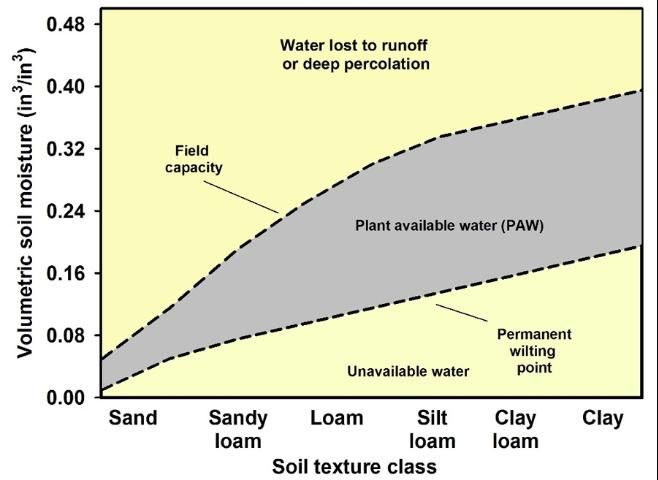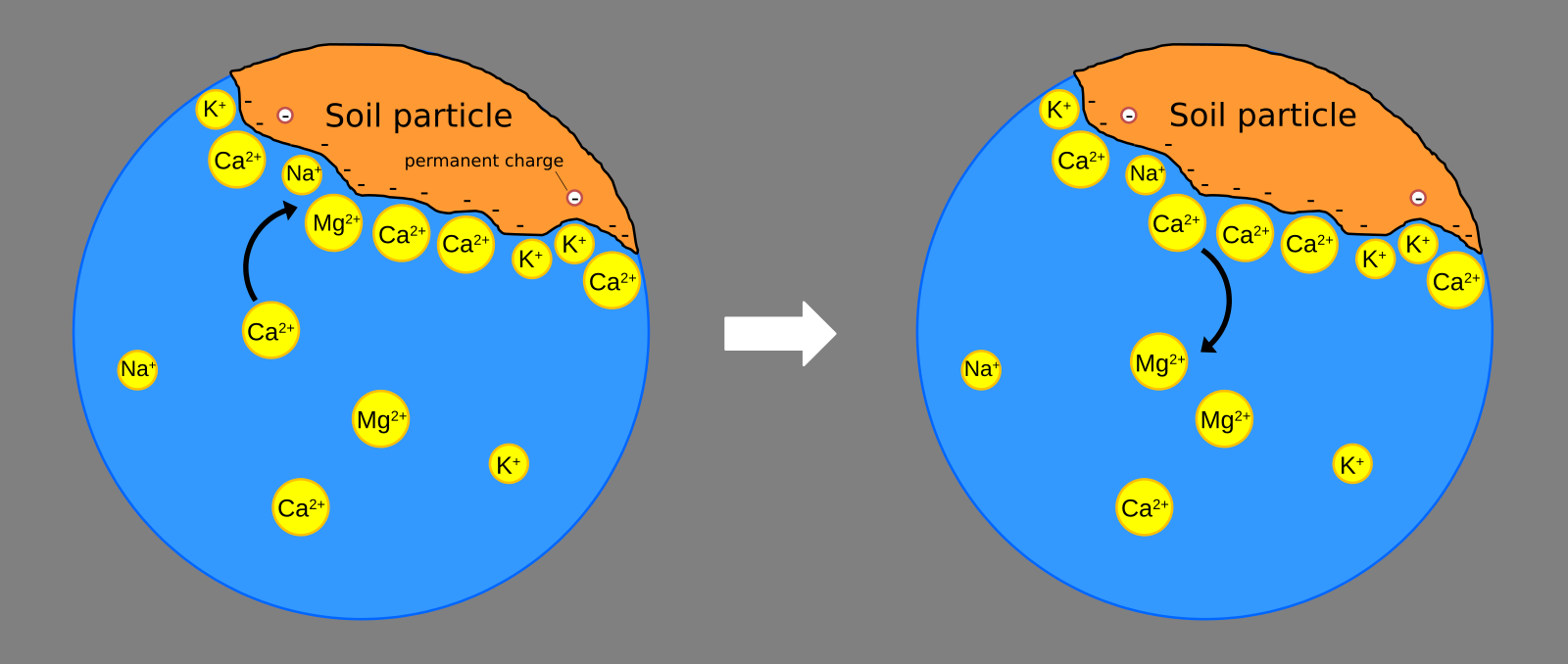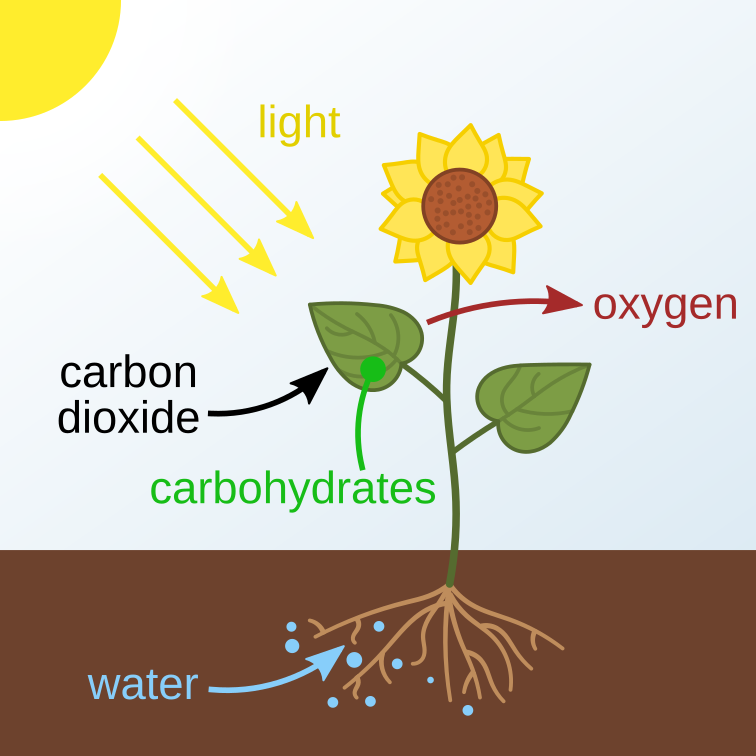IB Syllabus focus:
‘Soils provide water, rooting medium, and essential nutrients (N, P, K); plants obtain carbon from atmospheric CO₂.’
Soils are essential for sustaining plant productivity, acting as reservoirs for water, nutrients, and as a stable rooting medium. Their properties directly determine the success of agricultural systems.
Soils as a Rooting Medium
Plants require a stable rooting medium to anchor themselves and access resources. The soil must provide:
Mechanical support to hold plants upright.
Pore space for oxygen to reach roots.
Channels for root penetration and growth.
Soil Structure and Root Development
A well-aggregated soil with balanced sand, silt, and clay particles promotes effective root growth. Compacted or degraded soils restrict root extension and limit productivity.
Water Availability in Soils
Water stored in soils provides plants with a continuous supply between rainfall or irrigation events.
Field Capacity: The amount of water soil can hold against gravity after excess drainage has occurred.
Types of Soil Water
Gravitational water: Quickly drains, unavailable to plants.
Capillary water: Held in pores, readily available to roots.
Hygroscopic water: Bound tightly to particles, unavailable to plants.
Soil texture and organic matter content influence water retention. Clay and humus-rich soils store more water than sandy soils.

Diagram shows field capacity, permanent wilting point, and the grey band of plant-available water across soil textures from sand to clay. It clarifies why clays retain more water while sands hold less, aligning with irrigation decisions and plant stress thresholds. Note: the graphic also labels water lost to runoff or deep percolation, which is ancillary detail beyond the syllabus focus. Source.
Nutrient Supply in Soils
Soils supply the essential macronutrients plants require:
Nitrogen (N): For proteins and chlorophyll synthesis.
Phosphorus (P): For energy transfer and root development.
Potassium (K): For enzyme activation, water regulation, and disease resistance.
Cation Exchange Capacity (CEC): The ability of soil particles, especially clays and organic matter, to retain and exchange positively charged nutrient ions (cations).
Soils with high CEC, such as those rich in clay and humus, are more fertile because they can store and release nutrients efficiently.

Conceptual diagram of a negatively charged soil particle attracting nutrient cations in the surrounding solution, with arrows indicating exchange to and from the particle surface. This visual ties directly to CEC and explains why clay- and humus-rich soils buffer nutrient supply to roots. The labels are minimal and clear, avoiding clutter while showing the key ions. Source.
Micronutrients
Alongside macronutrients, soils provide micronutrients such as iron (Fe), manganese (Mn), and zinc (Zn), needed in smaller amounts but still essential for plant growth.
The Role of Organic Matter
Organic matter, particularly humus, improves soil fertility by:
Enhancing water retention.
Boosting nutrient availability through slow decomposition.
Promoting soil structure stability, reducing erosion.
Providing habitat and energy for soil microorganisms involved in nutrient cycling.
Humus: The dark, stable organic component of soil formed from decomposed plant and animal material, critical for fertility.
Plant Uptake of Carbon
While soils supply nutrients and water, carbon is obtained differently. Plants absorb carbon dioxide (CO₂) from the atmosphere during photosynthesis, not from the soil.

Simple, labelled schematic showing a plant taking in light, carbon dioxide (air), and water (roots), producing oxygen and carbohydrates. It visually distinguishes soil-supplied water/nutrients from air-supplied carbon, matching the syllabus focus. Extra detail includes oxygen release and “carbohydrates,” which are accurate but extend slightly beyond the precise wording. Source.
Photosynthesis: 6CO₂ + 6H₂O → C₆H₁₂O₆ + 6O₂
CO₂ = Carbon dioxide from the atmosphere
H₂O = Water from soil uptake
C₆H₁₂O₆ = Glucose (plant sugar for energy and growth)
O₂ = Oxygen released into the atmosphere
This balance between soil-provided resources and atmospheric CO₂ ensures full plant development.
Soil Conditions Affecting Productivity
Several soil conditions determine how well soils support plants:
Soil pH: Influences nutrient availability; extremes cause deficiencies or toxicities.
Aeration: Adequate oxygen is required for root respiration.
Temperature: Influences microbial activity and nutrient cycling.
Drainage: Prevents waterlogging, which restricts root oxygen supply.
Soil Biota and Productivity
Soil hosts diverse microorganisms and fauna that enhance productivity:
Decomposers (bacteria, fungi): Release nutrients through organic matter breakdown.
Mycorrhizal fungi: Extend root systems and improve phosphorus uptake.
Earthworms: Mix soil layers, increase aeration, and enhance structure.
These biological processes sustain nutrient cycling, maintaining long-term fertility.
Human Influence on Soil Productivity
Agricultural practices shape soil’s ability to support plants:
Irrigation provides water in dry areas but can lead to salinisation.
Fertiliser application replenishes nutrients but risks leaching and pollution.
Tillage influences aeration and rooting but may damage structure.
Organic amendments (manure, compost) enhance fertility and microbial activity.
Balancing these interventions is critical for sustainable productivity.
Summary of Soil Contributions to Plant Growth
Soils underpin productivity by providing:
Water availability through retention and supply mechanisms.
Nutrient supply, particularly N, P, and K, plus essential micronutrients.
Rooting medium with structure and aeration.
Support for biological activity that drives nutrient cycling.
Together with atmospheric CO₂ uptake, soils enable plants to grow, reproduce, and form the basis of terrestrial ecosystems and food production systems.
FAQ
Coarse sandy soils drain quickly, leaving little water available, so plants in sandy soils experience drought stress sooner.
In contrast, clay soils retain more capillary water, delaying stress, but if poorly structured, they may restrict root access to water.
Organic matter improves resilience by boosting moisture retention across all textures.
Nitrogen (N): Builds amino acids, proteins, and chlorophyll.
Phosphorus (P): Drives energy transfer in ATP and strengthens root systems.
Potassium (K): Regulates stomatal function, enzyme activation, and water use.
These three are required in larger quantities than other nutrients and directly control growth and productivity.
Well-aerated soils allow oxygen to reach roots for respiration, enabling energy release for nutrient uptake.
Poor aeration, often due to compaction or waterlogging, reduces oxygen availability, causing stunted growth and root decay.
Earthworms improve infiltration and drainage through burrowing.
Mycorrhizal fungi extend root networks, enhancing water and phosphorus absorption.
Decomposer organisms recycle organic matter into plant-available nutrients.
These interactions increase soil efficiency in supporting productivity.
Nutrient solubility depends on pH:
Acidic soils may leach calcium and magnesium and increase toxic aluminium.
Alkaline soils may lock phosphorus and micronutrients like iron.
Optimal productivity typically occurs around pH 6–7, where most nutrients are readily available.
Practice Questions
Question 1 (2 marks)
Identify two essential macronutrients provided by soils that support plant productivity.
Mark Scheme:
1 mark for correctly naming nitrogen (N).
1 mark for correctly naming phosphorus (P) or potassium (K).
(Maximum 2 marks.)
Question 2 (5 marks)
Explain how soils support plant productivity, with reference to water availability, rooting medium, and nutrient sup
Mark Scheme:
Up to 2 marks for describing water availability: e.g., soils store water, capillary water available to roots, differences between sandy and clay soils. (1–2 marks)
1 mark for explaining the rooting medium: soils provide physical support, aeration, and pore space for root growth. (1 mark)
Up to 2 marks for describing nutrient supply: soils provide essential nutrients (N, P, K) and micronutrients; cation exchange capacity influences fertility. (1–2 marks)
(Maximum 5 marks.)

